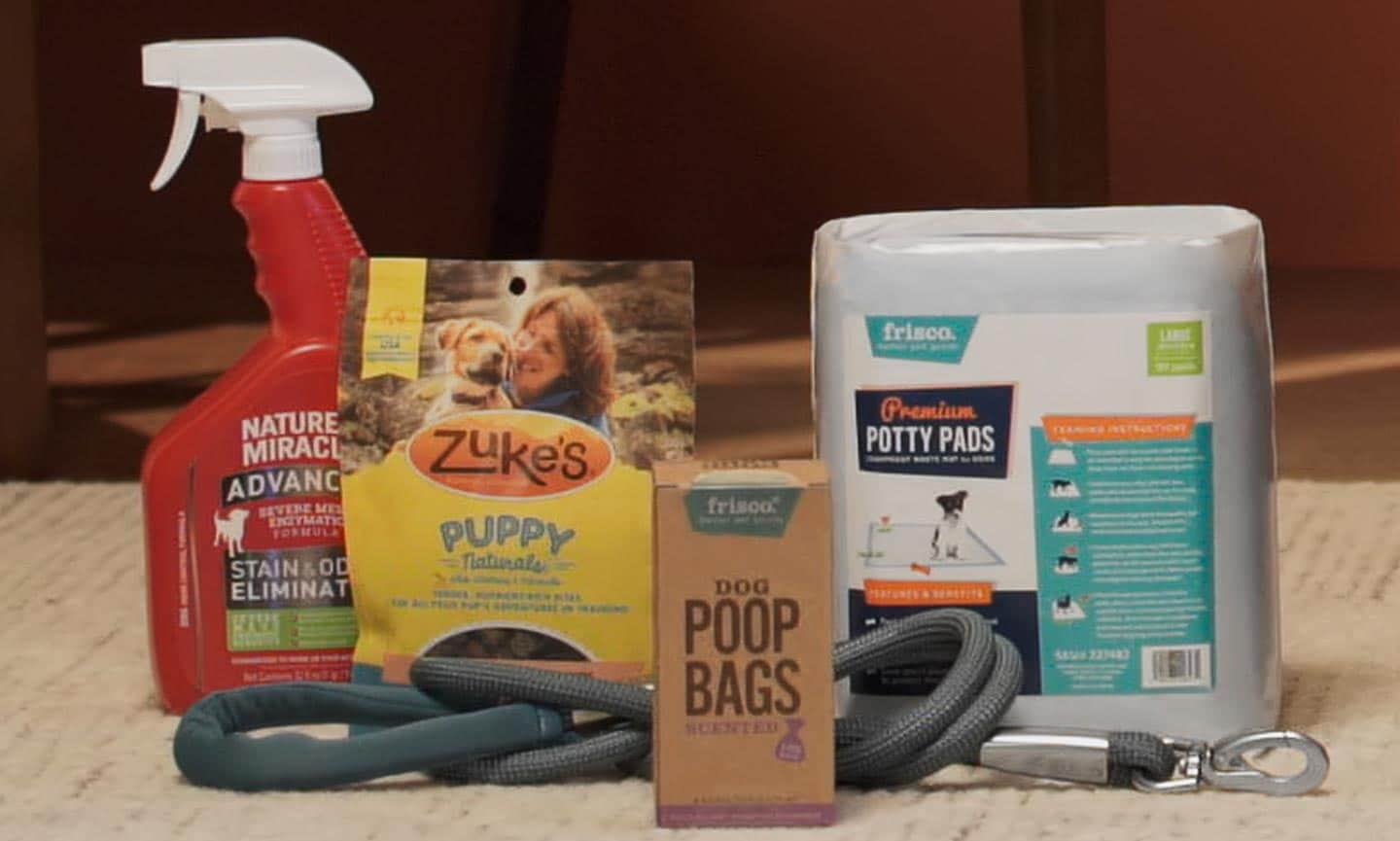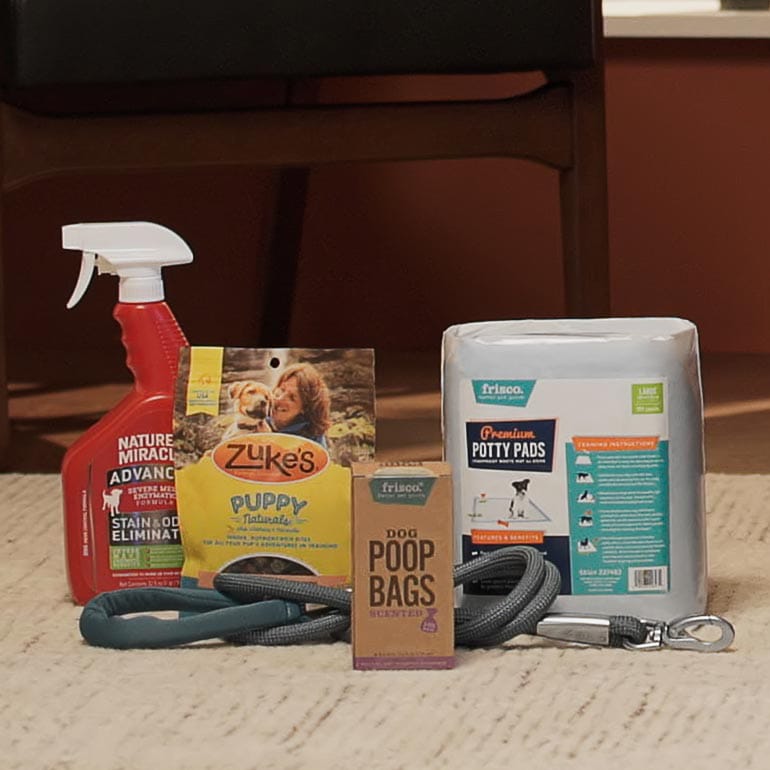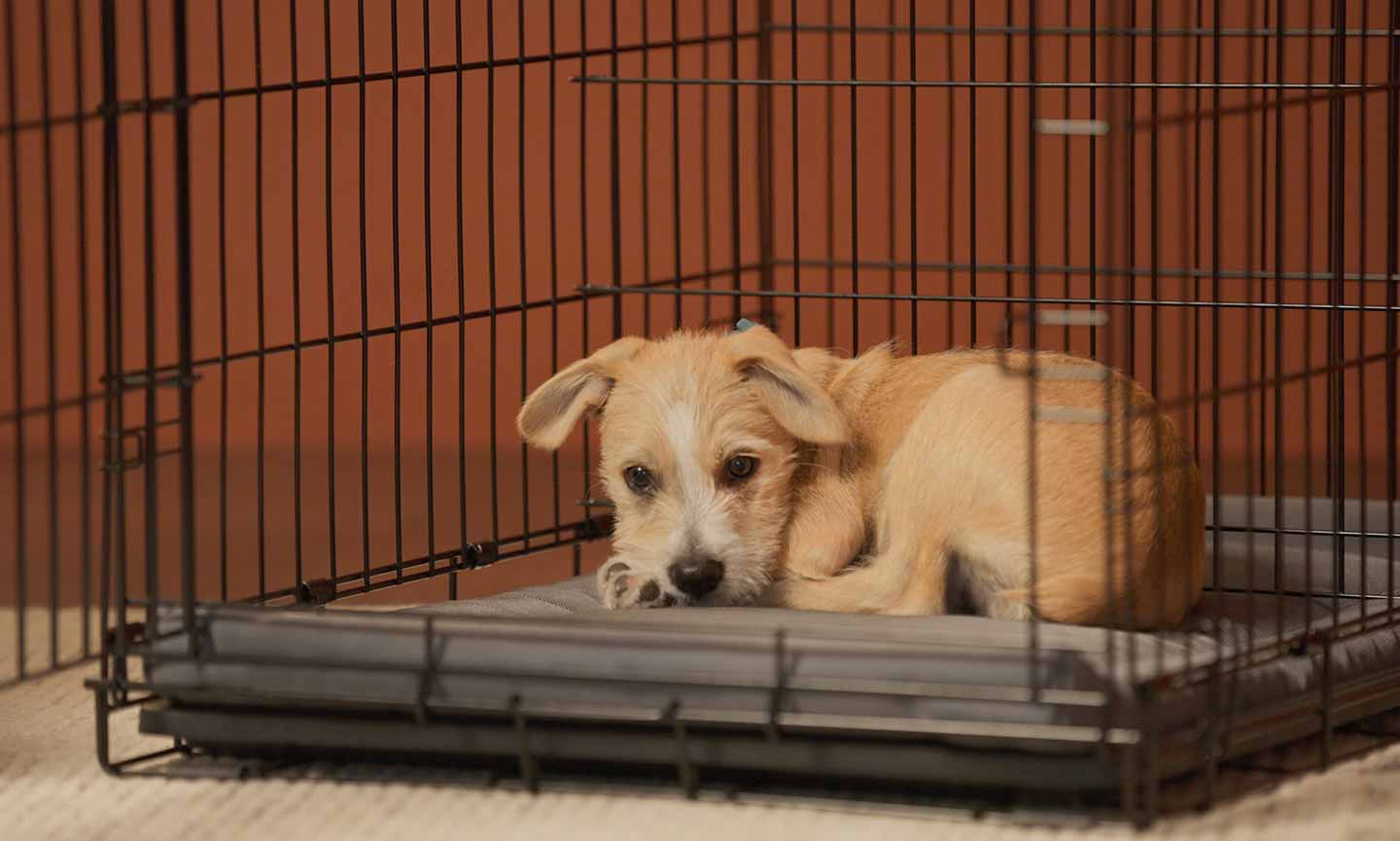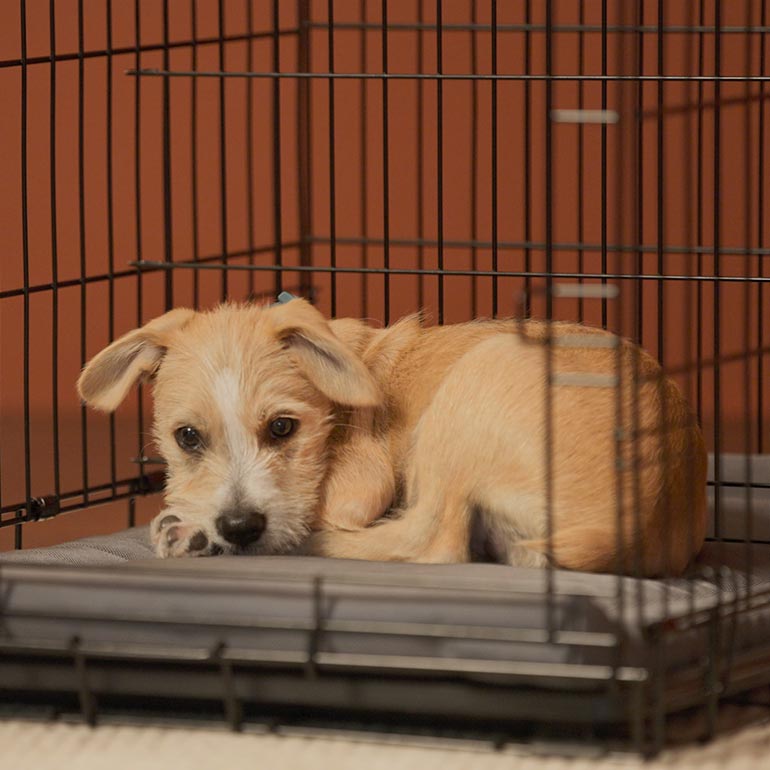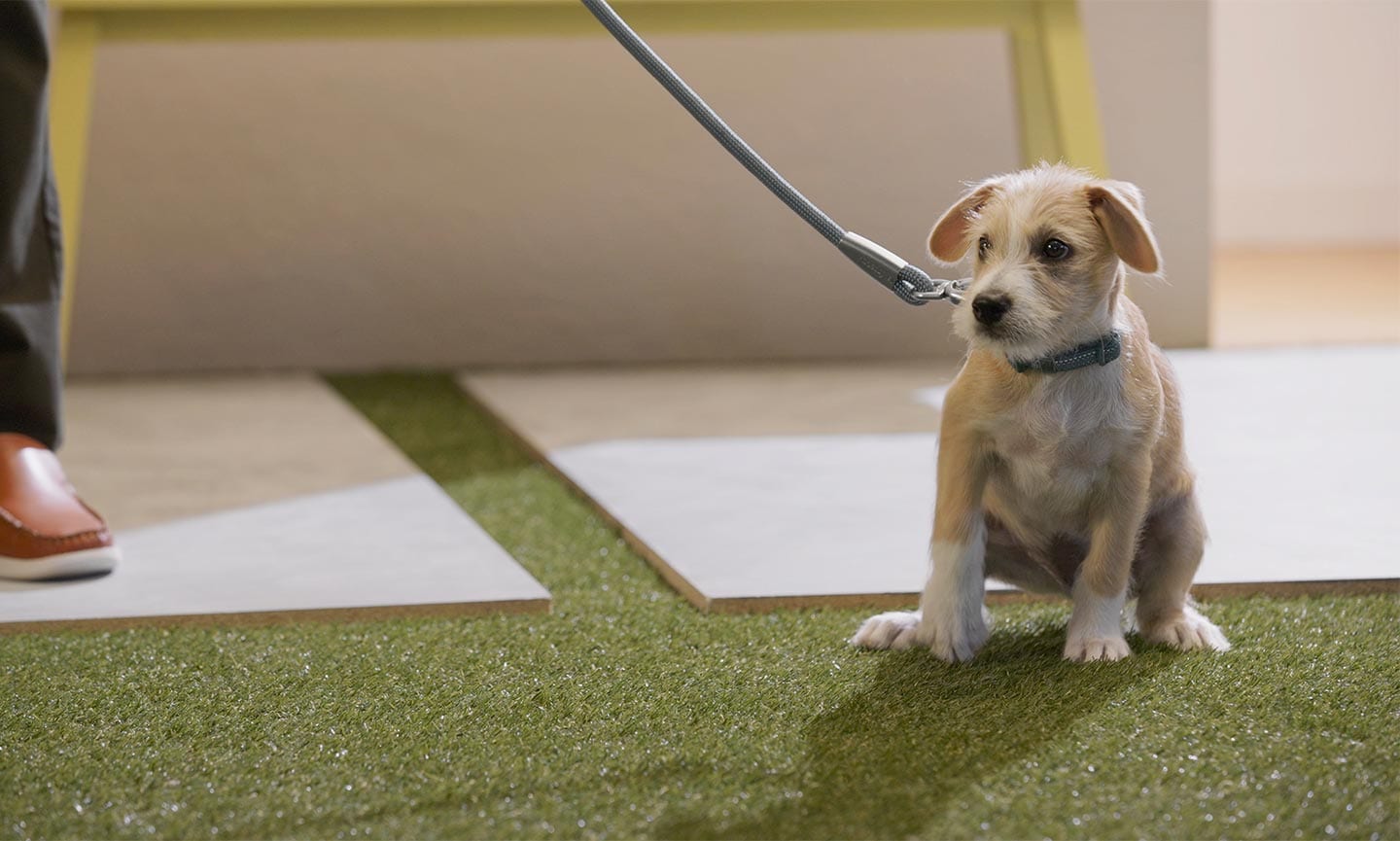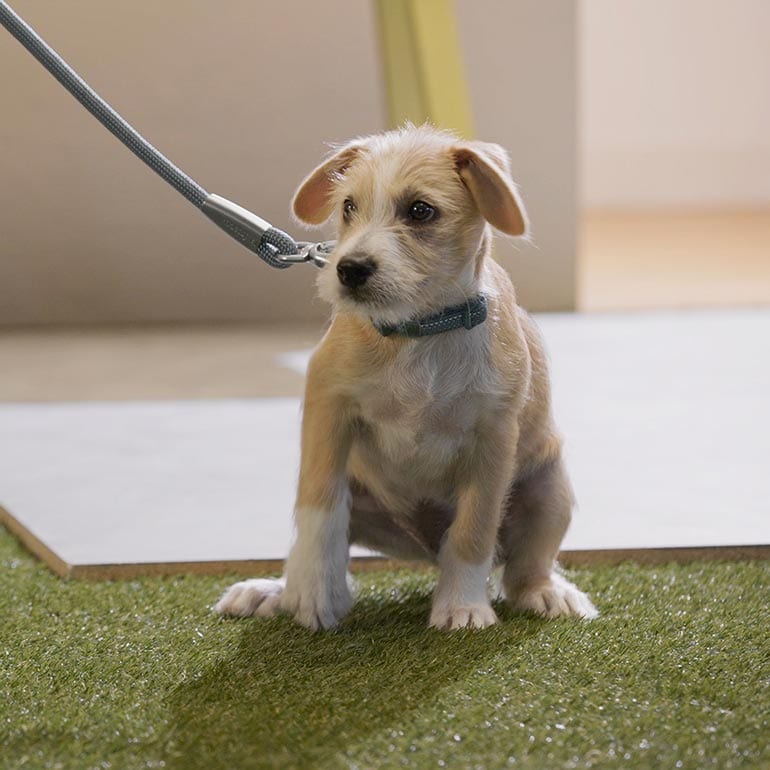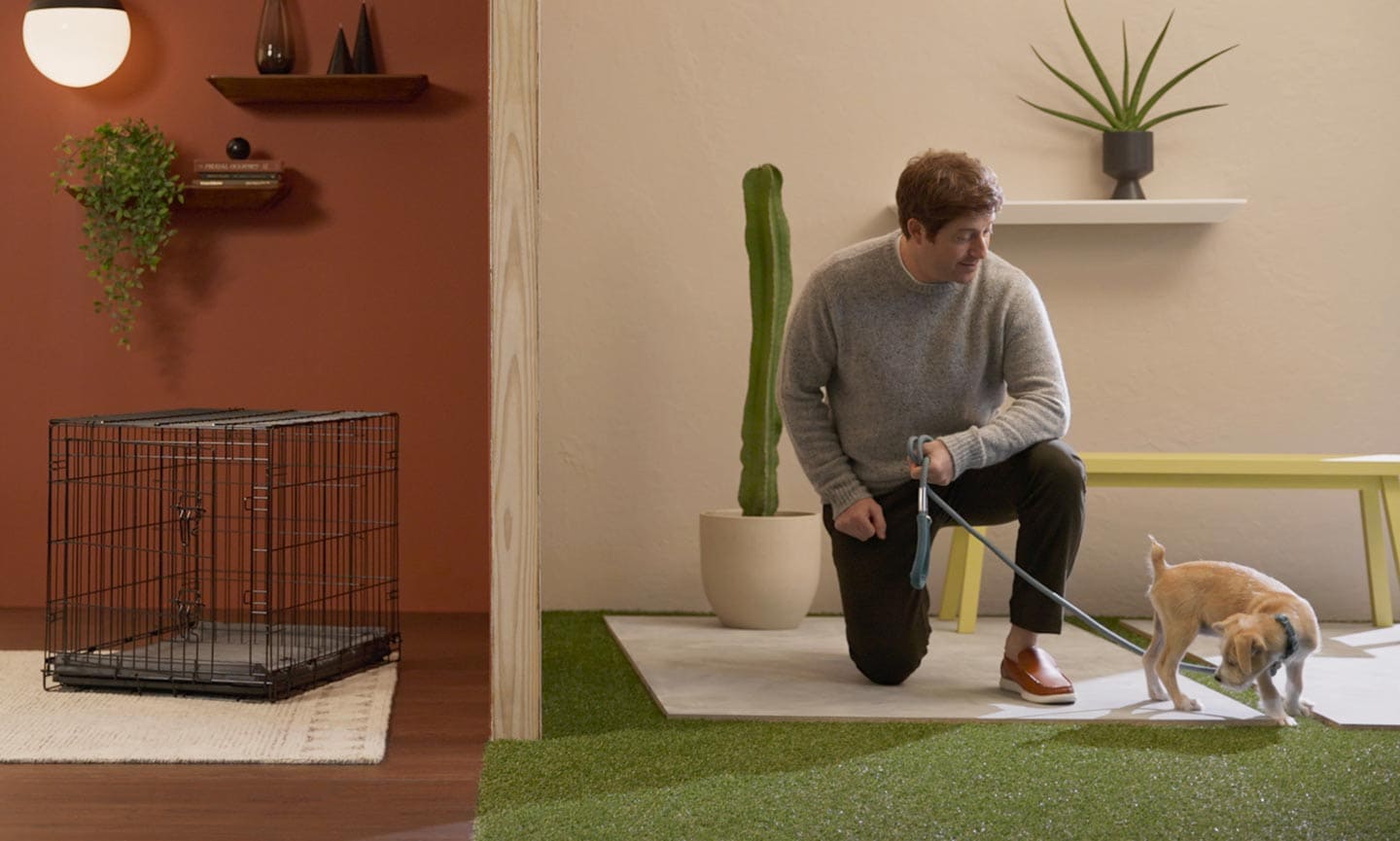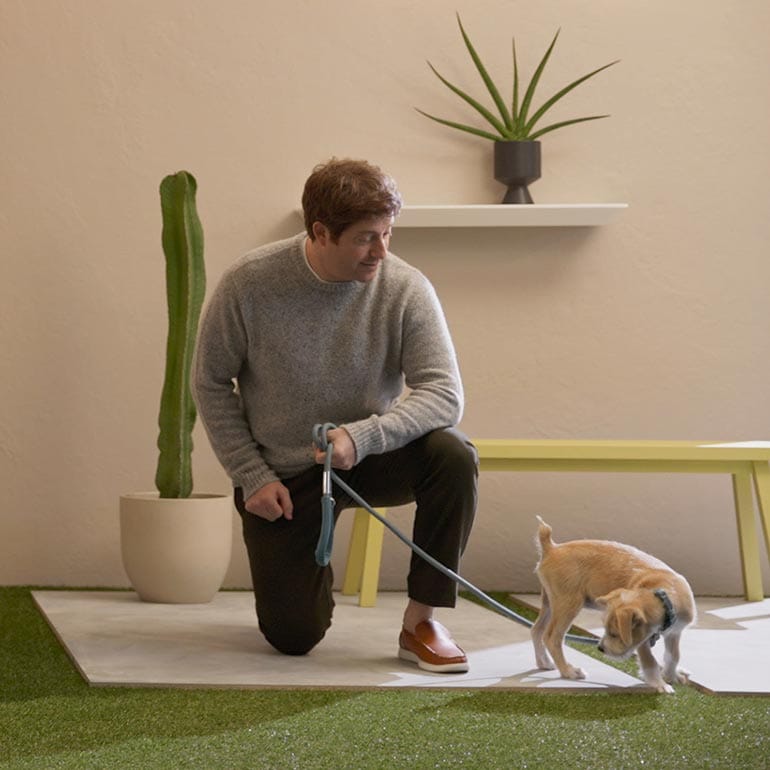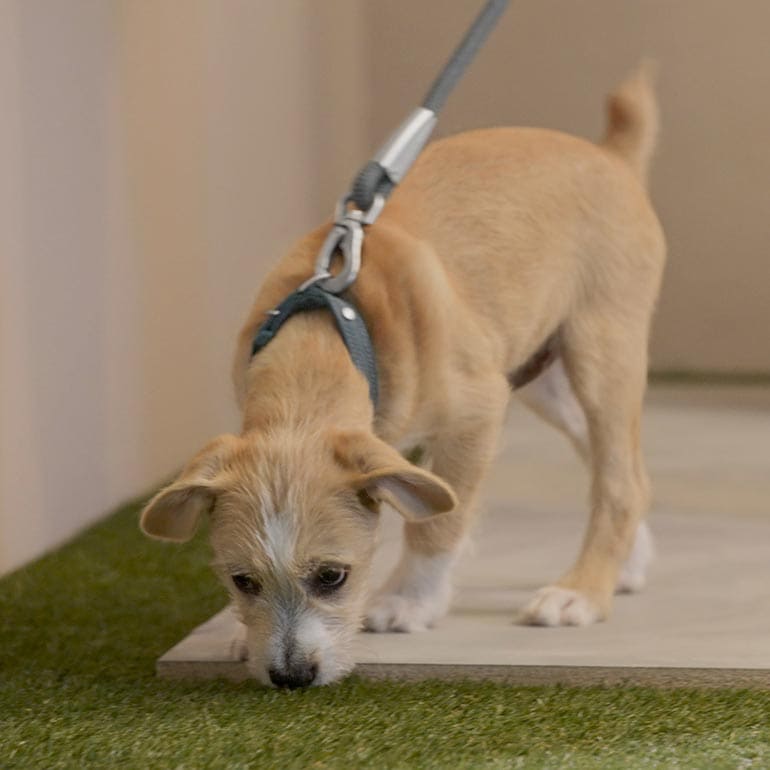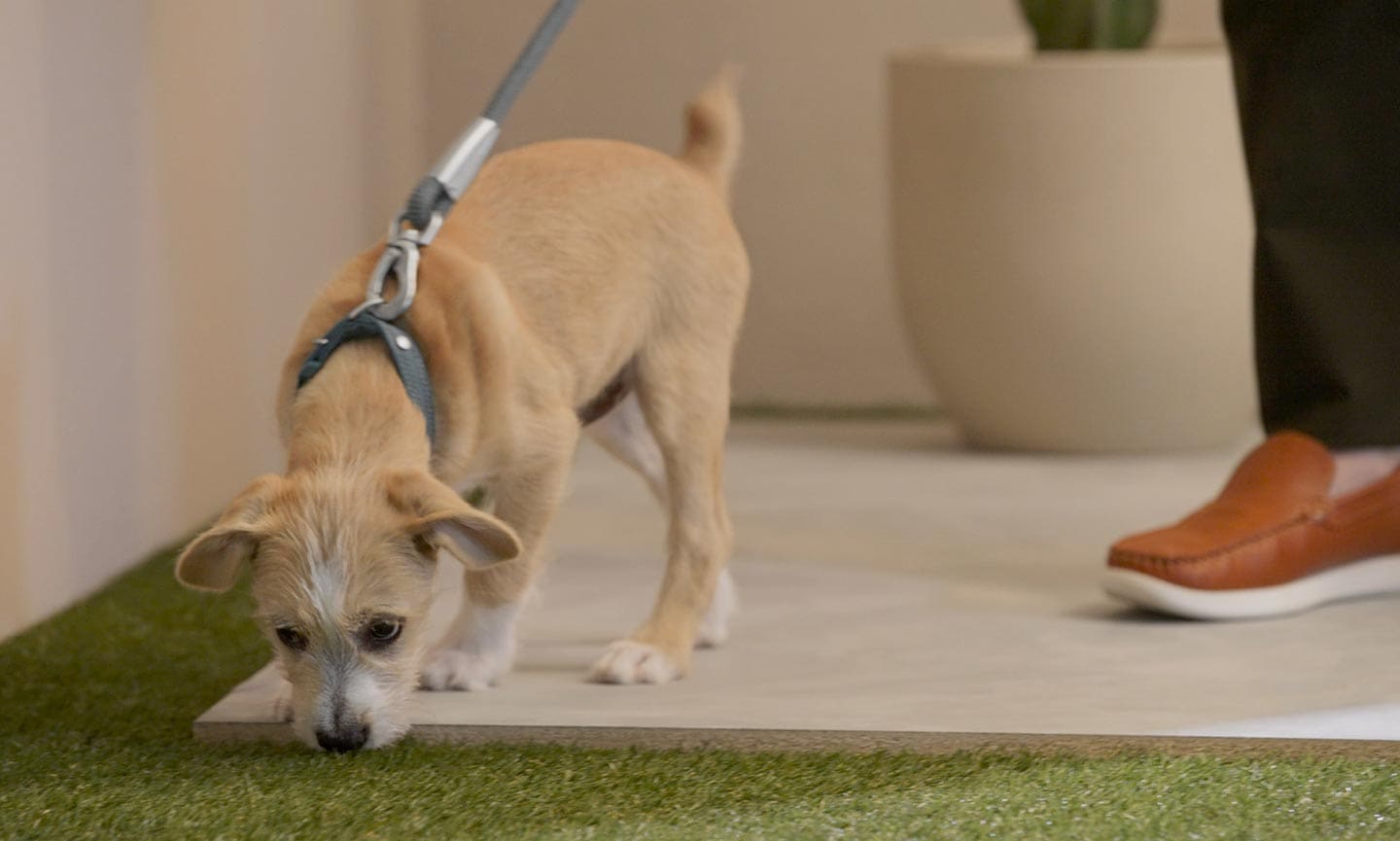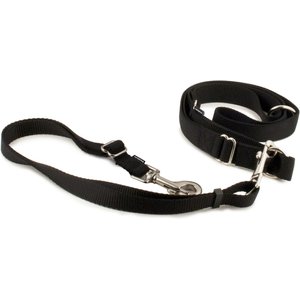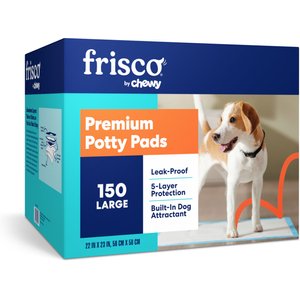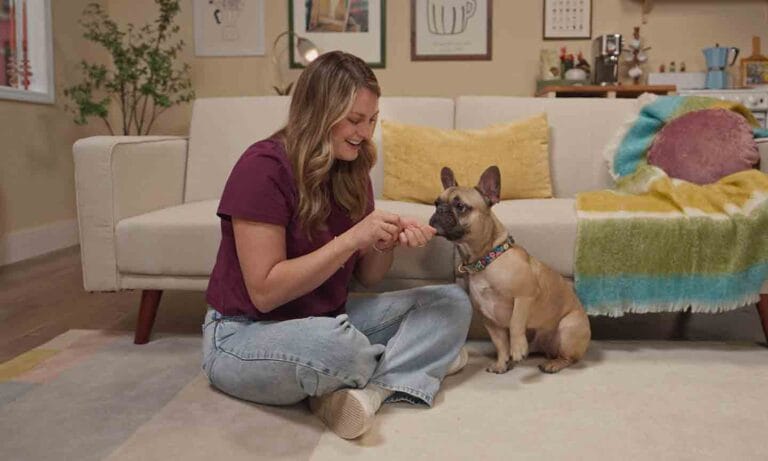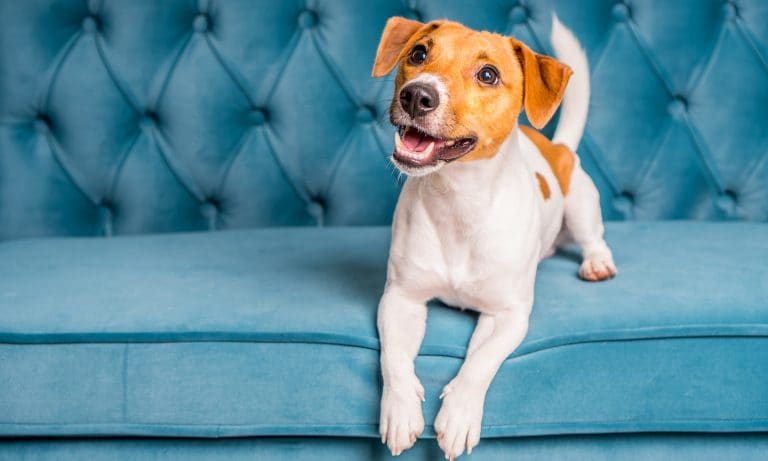House training (or potty training) may be one of the most important things you do with your new puppy. Everyone—whether two- or four-legged—is happier when puppy knows the rules of the road about where and when to go potty.
As you work on potty training for a puppy, keep in mind that it’s natural for a puppy to view the whole world as one giant potty area. The keys to teaching your puppy where to take potty breaks are regular outings, proper management, appropriate supervision and positive reinforcement. (Punishment has no place in potty training!) It is a process that takes both time and patience, but you and your puppy can master this important task.
So how long does it take to potty train a puppy? That largely depends on how consistent you are and how long your puppy can hold it. (Small breed puppies typically have a harder time holding it than large breed puppies, for example.) Below are steps for how to toilet train a puppy in seven days. You may find it takes a little longer with your own puppy, and that’s OK!
Equipment for Potty Training a Puppy
- Collar or harness
- Hands-free 3-4 foot non-retractable leash
- 15-foot non-retractable leash
- Two dog litter boxes or two frames that hold wee-wee pads
- Wee-wee pads
- Tasty small-sized treats
- Carpet cleaner for pet stains
- Mops and floor cleaner
- Lots of love!
How to Potty Train a Puppy in 7 Days
Potty training a puppy is all about setting you and your puppy up for success. Proper management and supervision are crucial to successful house training. Until your puppy is fully house trained, make sure your puppy is always either managed or supervised.
Management can mean several things.
Tethered
Tethering to an object ensures the puppy can’t go beyond a certain boundary. The Frisco Tie Out Cable is useful for this purpose—just make sure to set it up so the puppy can only access a puppy-proofed area while tethered.
Tethering to a person makes it easier for the person to monitor the puppy’s behavior. You can use a Tuff Mutt Hands-Free Bungee Leash to tie the puppy to you comfortably.
Confined
To help prevent peeing on the floor, confine the puppy in an area with potty pads. The potty pads are especially important if the puppy will have to wait a long time between potty breaks.
Use a gate, such as the Carlson Pet Products Extra Wide Walk-Thru Gate or a MidWest Steel Pet Gate, to block off a small room such as the kitchen or bathroom. (Tile is easier to clean in case of accidents.)
You can also set up a free-standing confinement area using an ex-pen such as the Frisco Dog Exercise Pen.
Wondering how to train your dog to use dog pee pads? Find out more here.
Crated
If you are going to crate train your puppy, make sure the puppy is comfortable in the crate. It should be just big enough for your puppy to turn around and lie down, but not much larger. That way, the puppy can stretch out a little, but they can’t potty in the corner and then snooze comfortably in another corner.
Crates such as the Frisco Fold & Carry Double Door Dog Crate or Frisco Indoor & Outdoor Soft Dog Crate work for brief periods of confinement and to help prevent accidents overnight. If your puppy keeps scaling barriers, another option is to tether the puppy to an object in a puppy-proofed area, using the 10-foot Frisco Tie Out Cable.
See the best-selling and top-rated dog crates tested and approved by dog parents, like you.
Outdoors (some of the time)
Pottying that happens outside is an opportunity for positive reinforcement for going in the right place, and the more often you reinforce appropriate pottying, the faster your puppy will be house trained. It’s still important to keep an eye on the puppy, though, so you know if the puppy has pottied or not.
Supervision
“Supervised” means someone is actively watching the puppy—meaning, the person is not on the computer, not on the phone, not cooking dinner and not watching television. The person supervising should be actively looking at and interacting with the puppy at all times. That gives the person much better odds of noticing if the puppy seems to need to potty or is starting to squat.
If that sounds like a lot of work, that’s because it is, which is why it’s so important to have appropriate management set up as well.
Important Note on Crate Training
A young puppy should never be crated for more than a couple of hours, except overnight. Your puppy might not be able to hold it very long.
If they’re crated for too long, they may start pottying in the crate out of desperation.
Keep crate time to a couple of hours or less, except at night. Listen for “I need to potty” barks or whines in the middle of the night, too, so you can give your puppy an overnight potty break whenever necessary.
Setting Up Successful Potty Breaks
Now that you know how to handle your puppy between potty breaks, here’s how to house train a puppy by creating a consistent schedule that helps your puppy learn the right habits.
Take your puppy out at least once every 30 minutes.
Take your puppy out on leash. Being on leash helps your puppy learn to potty on leash in general, which is useful because you’ll probably want your dog to potty on walks at some point. It also keeps the puppy from running around and getting distracted by all the interesting things around them.
Give your puppy five minutes, watching the whole time to see if the puppy pees or poops.
Stand still in one spot, in an area where it’s OK for your puppy to potty. Quietly watch the puppy.
By standing still, you keep the puppy in a small enough area that they will get bored with exploring fairly quickly and focus on pottying faster.
By keeping quiet, you help your puppy stay focused on pottying, instead of interacting with you.
Praise and offer a treat if the puppy pees or poops outside within five minutes.
Wait until the puppy has finished pottying. You don’t want to interrupt the puppy and have them finish that potty indoors!
As soon as you’re sure the puppy is done pottying, offer praise and hand them a tasty treat.
Note: If puppy does not pee or poop within five minutes, that’s OK. Take puppy to a confinement area for 10 to 20 minutes. After 10 or 20 minutes, go back to Step 1.
After the puppy pees or poops, give the puppy off-leash fun time.
Fun time can take place outdoors if it’s a safe area to be off leash (and if your puppy likes being outdoors), or indoors under supervision if outdoors is not an option (or if your puppy doesn’t want to stay outdoors).
Giving your puppy off-leash fun time once the puppy pees or poops teaches the puppy that pottying leads to more fun.
Most importantly, avoid the common mistake of confining the puppy right after they potty. If you bring the puppy back to their confinement area right after a successful mission, they learn that pottying ends the fun. Then they may start to wait longer and longer to potty, which is the opposite of what you want, right?
Repeat these steps throughout the day.
Give your puppy lots of chances to potty in an appropriate potty area. Then use positive reinforcement (treats, play, praise) to encourage your puppy to keep pottying in those areas.
The more times your puppy gets it right (and the fewer times your puppy has an accident), the faster your puppy will learn the routine.
Cheat Sheet
- Take your puppy to a potty area (outdoors or indoors) on leash at least once every 30 minutes while you are home and awake. At night, one or two outings are enough for most puppies.
- Stand still and quietly watch to see if the puppy pees or poops.
- Praise and offer a treat as soon as the puppy pees or poops outside. If the puppy does not pee or poop, that’s OK—take the puppy back to a confinement area for 10 to 20 minutes, and then outside again.
- After the puppy pees or poops, play with the puppy outdoors, or give puppy up to 15 minutes of carefully supervised time in the house (whichever the puppy prefers).
- Repeat these steps throughout the day.
Expert Tip
Create a house training chart or use a notepad to keep track of when and where the puppy pees and poops, so you can learn their patterns
Tips To Speed Up House Training a Puppy
Keep track of your puppy’s potty habits
Create a house training chart or use a notepad to take notes about when and where your puppy potties, so you can learn their patterns. This information will help you learn which times of day your puppy is most likely to potty, when and where they tend to have accidents, and when they probably don’t need to go to the potty area.
In time, the chart will help you figure out what areas should be off-limits for now and if you can skip a 30-minute potty break here and there.
In addition to regular 30-minute potty breaks, take your puppy to the potty area at these likely potty times:
- After eating
- After drinking
- After five to 10 minutes of play or other vigorous activity
- Immediately after waking up from a nap
Get your puppy on a feeding schedule
One good way to get pottying under control is to put your puppy on a feeding schedule.
In addition to pottying right after eating, many puppies potty again some regular period of time after eating. If you note a) when you feed your puppy and b) when your puppy potties between meals, you can start to find patterns. Use your notes to make sure your puppy always goes out to a potty area at the right times after eating.
With a feeding schedule, you give your puppy regular meals, at regular times, rather than leaving the food bowl out all the time. Fixed meal times make it easier to set up a schedule of potty breaks. The right feeding schedule depends on age, size and more, so ask your veterinarian to help you figure out a feeding schedule for your puppy.
Download our Puppy Feeding Schedule printable.
What if my puppy potties in the wrong place?
If you see your puppy having an accident, calmly take the puppy outside and then praise and offer a treat for going in the right place. Fight the urge to yell or scold! Punishing your puppy, whether by yelling and scolding or pushing the puppy’s nose into the urine, will not help.
Punishing your puppy usually teaches them to pee and poop where you can’t see them. In other words, they won’t stop pottying in the house; they’ll just hide before they do their business. This is because puppies often misinterpret punishment to mean they shouldn't potty in front of you. The nuance that the punishment was about pottying indoors may be totally lost on them.
Clean up past accidents thoroughly
The odor from past accidents is like a “restroom” sign for your dog. Identify the spot and use a cleaner designed for pet stains, such as Nature's Miracle or Skout's Honor.
After you clean, get on your hands and knees and sniff the area to make sure the smell is gone. You may also want to sniff other areas, just in case—you’d be amazed how many “missed” pee spots I’ve found this way!
Potty Training FAQs
Q: Why is my dog regressing with potty training?
A: If your puppy is regressing with potty training, the first thing to do is review your house training chart. Have you started giving your puppy fewer potty breaks? Has the feeding schedule changed? Has anything else changed that might affect the puppy’s house training?
Make sure to pay attention to when and where the accidents are happening. If you notice accidents are always happening in the same room, limit your puppy’s access to that room for a while. If the accidents are always happening at the same time, make sure to add a potty break at that time.
By the way, if the puppy keeps peeing when you come home from work, your puppy may be peeing out of excitement—in which case, the puppy probably has no idea they are peeing! Some puppies lose control of their bladder when they are excited (just like some people leak a little urine when they laugh).
To reduce the likelihood of these unconscious peeing incidents, avoid bending over or petting your puppy as you enter. You may even need to ignore the puppy for a minute or two after you get home. You can also try greeting your puppy outdoors or in an area that is easy to clean up. The good news is that most dogs will grow out of this problem.
Important Note: Even if the excited peeing keeps happening, don’t let the puppy know you are annoyed! If you start punishing your puppy for these accidents, your puppy will be even more anxious, which will make it even harder for them to keep control of their bladder. Ignoring the pottying and keeping your behavior calm and low-key is the best solution.
Q: Do puppy potty training sprays work?
A: Potty training sprays, which are sprays that help a puppy learn where to potty, can be quite helpful in some cases. As mentioned earlier, the smell of urine or feces can be like a restroom sign. Potty training sprays let you set up restroom signs in designated potty areas.
Q: At what age should my dog be potty trained?
A: The age when a dog should be potty trained varies by breed and size, but most dogs can be fully potty trained by the time they are about nine months to 1 year old.
Note that “fully potty trained” means no accidents at all unless the dog is sick or asked to hold it for too long. A dog who is still having occasional accidents is not fully potty trained yet!
Most puppies can make a lot of progress in potty training before they are nine months old, but a variety of factors can make it hard for them to avoid an accident here and there. If you manage your puppy very well and follow all the guidelines above, though, you can get your puppy to the point where there are almost no accidents very quickly!
Q: Can dogs potty train themselves?
A: It would be nice if dogs could potty train themselves, but I have never seen this happen. Sometimes young puppies living with older house-trained dogs do learn to potty outdoors with their older “sibling,” but that doesn’t prevent them from pottying indoors too. No matter what, you will need to manage the puppy and follow a regular potty break schedule to get your puppy 100 percent potty trained.
House training is simple, but it isn’t necessarily easy. House training a puppy can be hard work at first, but the more consistent you are, the better. A little work up front will pay dividends for years to come, and the sooner you start, the sooner your puppy will learn—so get started right away!
More Puppy Training:
Share:


